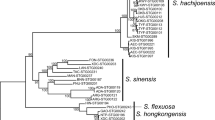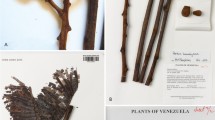Summary
Although the polyphyletic genus Scirpus L. s.l. (formerly > 200 species) has been divided into more than 50 separate genera and now consists of only 64 species, its circumscription remains problematical. Three new genera have been segregated from Scirpus s.s. in the past decade, and the delimitation of Scirpus from its possible sister genus Eriophorum L. (c. 18 species) is still unresolved. The primary character used to delimit Eriophorum from Scirpus is ≥ 10 smooth, elongate perianth bristles vs ≤ 6 short, serrulate bristles or a lack of bristles, but some species display character combinations that make it difficult to place them in either genus. Eriophorum crinigerum (A. Gray) Beetle (= Scirpus criniger A. Gray), endemic to the California Floristic Province, USA, is one such species, possessing a unique combination of bristle and inflorescence features that suggest affinities with both Scirpus and Eriophorum. In this study we use molecular (matK, ndhF), morphological, and embryological data to demonstrate that E. crinigerum is not closely related to either Scirpus or Eriophorum, but represents a new generic lineage, here named Calliscirpus C. N. Gilmour, J. R. Starr & Naczi (tribe Scirpeae). Within the genus, molecular (matK, ETS 1f) and morphological data strongly support the recognition of two species, each of which is restricted to a distinct region of high endemism. Calliscirpus criniger (A. Gray) C. N. Gilmour, J. R. Starr & Naczi comb. nov. is common to the Klamath-Siskiyou and North Coast mountain ranges of Oregon and California, whereas a new species, Calliscirpus brachythrix C. N. Gilmour, J. R. Starr & Naczi, is unique to the Sierra Nevada mountain range of California. Scirpus maximowiczii C. B. Clarke, another transitional species that has blurred the limits of Scirpus and Eriophorum, and has been cited as morphologically similar to Calliscirpus species in the past, is strongly placed within a Scirpus s.s. + Eriophorum s.s. clade (100% bootstrap) on the basis of molecular and embryological data. Tree support and taxonomic sampling are not sufficient to resolve the delimitation of Eriophorum s.s. from Scirpus s.s.








Similar content being viewed by others
References
Alexander, P. J., Rajanikanth, G., Bacon, C. D. & Bailey, C. D. (2007). Recovery of plant DNA using a reciprocating saw and silica-based columns. Molec. Ecol. Notes 7: 5 – 9.
Baldwin, B. G., Goldman, D. H., Keil, D. J., Patterson, R., Rosatti, T. J. & Wilken, D. H. (eds) (2012). The Jepson Manual: Vascular Plants of California, 2nd edition. University of California Press, Berkeley.
Ball, P. W. & Wujek, D. E. (2002). Eriophorum Linnaeus. In: Flora of North America Editorial Committee (eds), Flora of North America North of Mexico 23 (Cyperaceae), pp. 21 – 27. Oxford University Press, Oxford.
____, Reznicek, A. A. & Murray, D. F. (2002). Cyperaceae Jussieu. In: Flora of North America Editorial Committee (eds), Flora of North America North of Mexico 23 (Cyperaceae), pp. 3 – 608. Oxford University Press, Oxford.
Beetle, A. A. (1942). Scirpus criniger transferred to Eriophorum. Leafl. W. Bot. 3: 164 – 166.
____ (1946). Studies in the genus Scirpus L. VIII. Notes on its taxonomy, phylogeny, and distribution. Amer. J. Bot. 33: 660 – 666.
Bruhl, J. J. (1995). Sedge genera of the world: relationships and a new classification of the Cyperaceae. Austral. Syst. Bot. 8: 125 – 305.
Bunn, D., Mummert, A., Hoshovsky, M., Gilardi, K. & Shanks, S. (2007). California Wildlife: Conservation Challenges. California Department of Fish and Game.
DeBry, R. W. & Olmstead, R. G. (2000). A simulation study of reduced tree-search effort in bootstrap resampling analysis. Syst. Biol. 49: 171 – 179.
DellaSala, D. A., Reid, S. B., Frest, T. J., Strittholt, J. R. & Olson, D. M. (1999). A global perspective on the biodiversity of the Klamath-Siskiyou ecoregion. Nat. Areas J. 19: 300 – 319.
Dhooge, S. (2005). Systematic Revision and Phylogeny of the Andean Scirpoids (Cyperaceae, Scirpeae). Thesis.
____ & Goetghebeur, P. (2004). Phylloscirpus (Cyperaceae) revisited. Novon 14: 278 – 284.
____, Goetghebeur, P. & Muasya, A. M. (2003). Zameioscirpus, a new genus of Cyperaceae from South America. Pl. Syst. Evol. 243: 73 – 84.
Felsenstein, J. (1985). Phylogenies and the comparative method. Amer. Naturalist 125: 1 – 15.
Goetghebeur, P. (1986). Genera Cyperacearum. PhD. Dissertation, University of Ghent, Ghent.
____ (1998). Cyperaceae. In: K. Kubitzki (ed.), The Families and Genera of Vascular Plants 4. Flowering Plants Monocotyledons: Alismatanae and Commelinanae (except Gramineae), pp. 141 – 190. Springer, Berlin, Heidelberg, New York.
Gray, A. (1868). Characters of new plants of California and elsewhere, principally of those collected by H. N. Bolander in the State Geological Survey. Proc. Amer. Acad. Arts 7: 327 – 401.
Hammer, Ø., Harper, D. A. T. & Ryan, P. D. (2001). PAST: Paleontological statistics software package for education and data analysis. Palaeontol. Electron. 4: 9 pp. http://palaeo-electronica.org/2001_1/past/issue1_01.htm
Hickman, J. C. (1993). The Jepson Manual: Higher Plants of California. University of California Press, Los Angeles.
Hijmans, R. J., Guarino, L., Bussink, C. & Rojas, E. (2002). DIVA-GIS, Version 2. A Geographic Information System for the Analysis of Biodiversity Data. Manual. International Potato Center, Lima.
Irwin, W. P. (1966). Geology of the Klamath Mountains province. In: E. H. Bailey (ed.), Geology of Northern California, pp. 19 – 38. California Division of Mines and Geology, San Francisco.
IUCN (2001). IUCN Red List Categories and Criteria: Version 3.1. IUCN Species Survival Commission, IUCN, Gland and Cambridge.
Jung, J. & Choi, H. K. (2010). Systematic rearrangement of Korean Scirpus L. s.l. (Cyperaceae) as inferred from nuclear ITS and chloroplast rbcL sequences. J. Pl. Biol. 53: 222 – 232.
Khokhrjakov, A. P. (1985). Flora Magadanskoy Oblasti (Flora of the Magadan Province). Moscow: Nauka. (In Russian).
____ (1989). Analyz Flory Kolymskogo Nagor’ya (Analysis of the Kolyma Upland Flora). Moscow: Nauka. (In Russian).
Koyama, T. (1958). Taxonomic study of the genus Scirpus Linné. J. Fac. Sci., Univ. Tokyo, Sect. 3, Bot. 7: 271 – 366.
Linnaeus, C. (1753). Species Plantarum 1: 47. Impensis L. Salvii, Holmiae.
Miles, S. R. & Goudey, C. B. (1997). Ecological Subregions of California. USDA, Forest Service Pacific Southwest Region, San Francisco.
Muasya, A. M. & Simpson, D. A. (2002). A monograph of the genus Isolepis R. Br. (Cyperaceae). Kew Bull. 57: 257 – 362.
____, Simpson, D. A., Chase, M. W. & Culham, A. (1998). An assessment of suprageneric phylogeny in Cyperaceae using rbcL DNA sequences. Pl. Syst. Evol. 211: 257 – 271.
____, ____, ____ & ____ (2000). Phylogenetic relationships within the heterogeneous Scirpus sensu lato. (Cyperaceae) inferred from rbcL and trnL–F sequence data. In K. L. Wilson & D. A. Morrison (eds), Monocots: Systematics and Evolution, 610 – 614. CSIRO, Melbourne.
____, Vrijdaghs A., Simpson D. A., Chase M. W., Goetghebeur P. & Smets E. (2009a). What is a genus in Cyperaceae: phylogeny, character homology assessment and generic circumscription. Bot. Rev. 75: 52 – 66.
____, Simpson, D. A., Verboom, G. A., Goetghebeur, P., Naczi, R. F. C., Chase, M. W. & Smets, E. (2009b). Phylogeny of Cyperaceae based on DNA sequence data: current progress and future prospects. Bot. Rev. 75: 2 – 21.
____, Reynders, M., Goetghebeur, P., Simpson, D. A. & Vrijdaghs, A. (2012). Dracoscirpoides (Cyperaceae) — a new genus from Southern Africa, its taxonomy and floral ontogeny. S. African J. Bot. 78: 104 – 115.
Myers, N., Mittermeier, R. A., Mittermeier, C. G., da Fonseca, G. A. B. & Kent, J. (1999). Biodiversity hotspots for conservation priorities. Nature 403: 853 – 858.
Oteng-Yeboah, A. A. (1974). Taxonomic studies in Cyperaceae-Cyperoideae. Notes Roy. Bot. Gard. Edinburgh 33: 311 – 316.
Purdy, C. (1931). Bolander’s Red Mountain and Eureka Trail. Madroño 2: 33 – 34.
Safford, H. D., Viers, J. H. & Harrison, S. P. (2005). Serpentine endemism in the California flora: a database of serpentine affinity. Madroño 52: 222 – 257.
Schuller, R., Fritts, S. J. & Mousseaux, M. (2010). Woodcock Bog Research Natural Area: Guidebook Supplement 40. United States Department of Agriculture, Forest Service.
Schuyler, A. E. (1971). Some relationships in Scirpeae bearing on the delineation of genera. Mitt Bot. Staatssamml. München 10: 577 – 585.
Scott, C. W. (2010). Floristic affinities of Horse Mountain, Grouse Mountain, Board Camp Mountain and surrounding areas, Humboldt County, California. M.Sc. thesis. Humboldt State University.
Sikes, K. G. & Muir, P. S. (2009). Influence of two fuel reduction treatments on chaparral communities of southwestern OR. Madrono 56: 8 – 22.
Simpson, D. A., Muasya, A. M. Chayamarit, K., Parnell, J. A. N., Suddee, S., Wilde, B. D. E., Jones, M. B., Bruhl, J. J. & Pooma, R. (2005). Khaosokia caricoides, a new genus and species of Cyperaceae from Thailand. Bot. J. Linn. Soc. 149: 357 – 364.
Starr, J. R., Harris, S. A. & Simpson, D. A. (2003). Potential of the 5′ and 3′ ends of the intergenic spacer (IGS) of rDNA in the Cyperaceae: new sequences for lower-level phylogenies in sedges with an example from Uncinia Pers. Int. J. Pl. Sci. 164: 213 – 227.
____, ____ & ____ (2004). A phylogeny of the unispicate taxa in Cyperaceae tribe Cariceae I: generic relationships and evolutionary scenarios. Syst. Bot. 29: 528 – 544.
____, Naczi, R. F. C. & Chouinard, B. N. (2009). Plant DNA barcodes and species resolution in sedges (Carex, Cyperaceae). Molec. Ecol. Res. 9: 151 – 163.
Strong, M. T. (2003). Cypringlea, a new genus of Cyperaceae from Mexico. Novon 13: 123 – 132.
Swofford, D. L. (2002). PAUP*: Phylogenetic Analysis Using Parsimony (*and other methods). Sinauer Associates, Sunderland, Massachusetts.
Thompson, J. D., Gibson, T. J., Plewniak, F., Jeanmougin, F. & Higgins, D. G. (1997). The Clustal X Windows interface: flexible strategies for multiple sequence alignment aided by quality analysis tools. Nucl. Acids Res. 24: 4876 – 4882.
Thorne, J. H., Viers, J. H., Price, J. & Storns, D. M. (2009). Spatial patterns of endemic plants in California. Nat. Areas J. 29: 344 – 366.
Tucker, G. C. & Miller, N. G. (1990). Achene microstructure in Eriophorum (Cyperaceae): taxonomic implications and paleobotanical applications. Bull. Torrey Bot. Club 117: 266 – 283.
Van der Veken, P. (1965). Contribution à l’embryographie systématique des Cyperaceae-Cyperoideae. Bull. Jard. Bot. État Bruxelles 35: 285 – 354.
Walker, G. W. & MacLeod, N. S. (1991). Geologic map of Oregon: U.S. Geological Survey, scale 1:500000.
Whittemore, A. T. & Schuyler, A. E. (2002). Scirpus Linnaeus. In: Flora of North America Editorial Committee (eds), Flora of North America North of Mexico 23 (Cyperaceae), pp. 8 – 21. Oxford University Press, Oxford.
Wilson, K. L. (1981). A synopsis of the genus Scirpus sensu lato. (Cyperaceae) in Australia. Telopea 2: 153 – 172.
World Checklist of Selected Plant Families. (2010). The Board of Trustees of the Royal Botanic Gardens, Kew. Published on the Internet; http://www.kew.org/wcsp/ accessed 29 September 2010.
Acknowledgements
The authors would like to thank the curators of the following herbaria without whose specimens this study would not have been possible: A, CAN, CAS, CHSC, DAO, DOV, DS, JEPS, NY, OSC, PH, UC, US, WS. We would also like to thank Drs Paul Hamilton and André Martel of the Canadian Museum of Nature (CMN) for help with ESEM and light microscopy work. The comments of two anonymous reviewers were greatly appreciated. This research was conducted as part of the requirements for a M.Sc. at the University of Ottawa (UofO) with support from an NSERC Alexander Graham Bell Canadian Graduate Scholarship, an Ontario Graduate Scholarship, an Excellence Scholarship from the UofO, and a Systematics Research Graduate Supplement (CMN) to CNG. This research was funded by an NSERC Discovery Grant to JRS.
Author information
Authors and Affiliations
Corresponding author
Rights and permissions
About this article
Cite this article
Gilmour, C.N., Starr, J.R. & Naczi, R.F.C. Calliscirpus, a new genus for two narrow endemics of the California Floristic Province, C. criniger and C. brachythrix sp. nov. (Cyperaceae). Kew Bull 68, 85–105 (2013). https://doi.org/10.1007/s12225-012-9420-2
Accepted:
Published:
Issue Date:
DOI: https://doi.org/10.1007/s12225-012-9420-2




